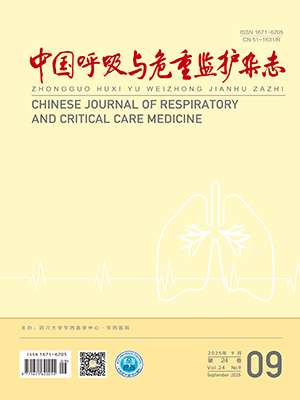| 1. |
File TM Jr, Marrie TJ. Burden of community-acquired pneumonia in North American adults. Postgrad Med, 2010, 122(2): 130-141.
|
| 2. |
Brar NK, Niederman MS. Management of community acquired pneumonia: a review and update. Ther Adv Respir Dis, 2011, 5: 61-78.
|
| 3. |
Garnacho-Montero J, Barrero-García I, Gómez-Prieto MG, et al. Severe community-acquired pneumonia: current management and future therapeutic alternatives. Expert Rev Ant Infect Ther, 2018, 16(9): 667-677.
|
| 4. |
Metlay JP, Waterer GW, Long AC, et al. Diagnosis and Treatment of Adults with Community-acquired Pneumonia. An Official Clinical Practice Guideline of the American Thoracic Society and Infectious Diseases Society of America. Am J Respir Crit Care Med, 2019, 200(7): e45-e67.
|
| 5. |
Ilg A, Moskowitz A, Konanki V, et al. Performance of the CURB-65 score in predicting critical care interventions in patients admitted with community-acquired pneumonia. Ann Emerg Med, 2019, 74(1): 60-68.
|
| 6. |
Sharp AL, Jones JP, Wu I, et al. CURB-65 performance among admitted and discharged emergency department patients with community-acquired pneumonia. Acad Emerg Med, 2016, 23(4): 400-405.
|
| 7. |
刘玉, 张嘉瑞, 罗远明, 等. 慢性阻塞性肺疾病急性加重合并社区获得性肺炎短期死亡及不良结局预测模型的验证研究. 中国呼吸与危重监护杂志, 2023, 22(3): 159-167.
|
| 8. |
符翔. 慢性阻塞性肺疾病合并重症肺炎患者免疫功能指标和血清降钙素原及前清蛋白检测的临床意义. 临床医药实践, 2020, 29(6): 430-433.
|
| 9. |
宋骄阳. 新型冠状病毒肺炎并发静脉血栓栓塞症的研究进展. 中国呼吸与危重监护杂志, 2021, 20(1): 58-63.
|
| 10. |
Guan WJ, Ni ZY, Hu U, et al. Clinical characteristics of coronavirus disease 2019 in China. N Engl J Med, 2020, 382(18): 1708-1720.
|
| 11. |
Mansory EM, Srigunapalan S, Lazo-Langner A. Venous thromboembolism in hospitalized critical and noncritical COVID-19 patients: a systematic review and meta-analysis. TH Open, 2021, 5(3): e286-e294.
|
| 12. |
Roberto C, Camilla C, Marco F, et al. Comparison of thrombotic events and mortality in patients with community-acquired pneumonia and COVID-19: a multicenter observational study. Thromb Haemost, 2022, 122(2): 257-266.
|
| 13. |
Heinemann LA, Dinger JC. Range of published estimates of venous thromboembolism incidence in young women. Contraception, 2007, 75(5): 328-336.
|
| 14. |
Nahum J, Morichau-Beauchant T, Daviaud F, et al. Venous thrombosis among critically ill patients with coronavirus disease 2019 (COVID-19). JAMA Netw, 2020, 3(5): e2010478.
|
| 15. |
秦立昊, 余海洋, 朴则宇, 等. 孤立性肺栓塞与深静脉血栓相关性肺栓塞的危险因素与发病机制的研究进展. 中国呼吸与危重监护杂志, 2023, 22(11): 821-824.
|
| 16. |
徐佳丽, 胡蓓蓓, 茅秋霞, 等. 新型冠状病毒肺炎患者的静脉血栓栓塞症风险评估与抗凝治疗. 中国呼吸与危重监护杂志, 2021, 20(2): 101-105.
|
| 17. |
Torres A, Cilloniz C, Niederman MS, et al. Pneumonia. Nat Rev Dis Primers, 2021, 7(1): 25.
|
| 18. |
黄泽波, 曾凡乔, 江祚龙, 等. 个体化预测CRRT治疗重症肺部感染相关脓毒症患者预后列线图模型的建立. 临床肺科杂志, 2022, 27(7): 1030-1041.
|
| 19. |
中华医学会呼吸病学分会肺栓塞与肺血管病学组, 中国医师协会呼吸医师分会肺栓塞与肺血管病工作委员会, 全国肺栓塞与肺血管病防治协作组. 肺血栓栓塞症诊治与预防指南. 中华医学杂志, 2018, 98(14): 1060-1087.
|
| 20. |
张炜宗, 袁红, 孙金栋, 等. 新型冠状病毒感染患者院内死亡危险因素的Meta分析. 中国全科医学, 2023, 26(5): 607-620.
|
| 21. |
Wong CK, Au IC, Lau KT, et al. Real-world effectiveness of molnupiravir and nirmatrelvir plus ritonavir against mortality, hospitalisation, and in-hospital outcomes among community-dwelling, ambulatory patients with confirmed SARS-CoV-2 infection during the omicron wave in Hong Kong: an observational study. Lancet, 2022, 400(10359): 1213-1222.
|
| 22. |
Arbel R, Wolff Sagy Y, Hoshen M, et al. Nirmatrelvir use and severe Covid-19 outcomes during the omicron surge. N Engl J Med, 2022, 387(9): 790-798.
|




